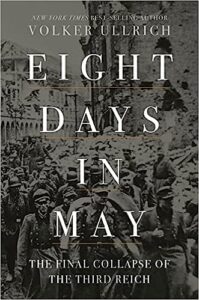PARIS PARALYZED ON EVE OF LIBERATION
Paris, Occupied France • August 10, 1944
On August 1, 1944, almost two months after the initial D-Day landings in Normandy, France, more than 14,000 personnel and equipment from 41-year-old Gen. Philippe Leclerc’s Free French 2nd Armored Division began landing on Utah Beach. Leclerc (1902–1947) juggled three roles: He was a subordinate divisional commander in an American army under the supreme command of Gen. Dwight D. Eisenhower, he was the commander of a separate national (French) force (2nd Armored Division), and he was Free French leader Gen. Charles de Gaulle’s man on the spot.
As the tide turned against Nazi Germany after the Allies’ Normandy breakout (August 1, 1944), Free French leaders wanted their own troops to lead the liberation of Paris, the heart and soul and symbol of the whole French nation. Parisians in fact were readying themselves for liberation—by themselves if necessary. Nine days after the citizens of Warsaw, Poland’s capital, began their uprising, French rail workers went on strike on this date, August 10, 1944. Five days later, as another Allied invasion took place in Southern France (Operation Dragoon), Paris police struck as well. By August 18 the French capital, a city of roughly 2 million people, was completely paralyzed. Sporadic street fighting broke out the next day. Parisians built barricades in the streets, sniped from rooftops at German Wehrmacht and Waffen‑SS soldiers evacuating the city (some in stolen French vehicles), and posted propaganda posters on walls assuring residents that “victory is near” and promising “chastisement for the traitors,” i.e., Vichy loyalists who had collaborated with the occupiers.
The German military governor of Paris, Gen. Dietrich von Choltitz, would have needed (according to a French estimate) between 60,000 and 135,000 first-line troops to hold and defend Paris. Short of anything close to those figures, Choltitz responded by cutting off all power and food supplies in the city. On August 23 radio listeners heard that Parisians were liberating themselves, an act that caused the Allied high command—which feared any insurrection that might result in the useless slaughter of civilians as was currently happening in Warsaw—to accelerate their drive eastward. Thus, on the night of August 24, an advance division of the Free French Army under Gen. Leclerc entered the French capital, its once beautiful buildings looking tired and faded after four years of war. The next day Leclerc accepted the surrender of the German garrison, which had shrunk to 5,000 mostly unenthusiastic men. Four years of pent-up frustration and hatred exploded over the heads of the German occupation forces and especially their French collaborators who had betrayed, tortured, and executed members of the Resistance. At least 11,000 collaborators were summarily executed before and after Choltitz surrendered Paris to Leclerc.
The Liberation of Paris, August 19–25, 1944
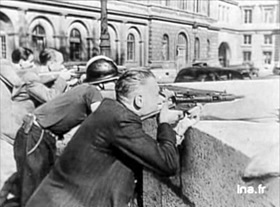 | 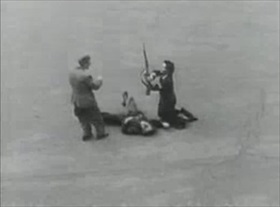 |
Left: On August 19, 1944, the first skirmishes between French irregulars (résistants) and the German occupiers began in Paris. Skirmishes reached their height of intensity on August 22 when some German units tried to leave their strongholds. It is estimated that 800–1,000 resistance fighters were killed during the battle for Paris and 1,500 wounded. Leclerc’s Free French 2nd Armored Division suffered 130 dead and just over 300 wounded. German losses were placed at 3,200 dead. Between June 6 and the collapse of the Wehrmacht in France in late 1944, hundreds of thousands of German soldiers would lose their lives. Total civilian and military deaths in France during World War II would exceed 567,000.
![]()
Right: Screenshot from the documentary “La Libération de Paris,” which was secretly shot by the French Resistance during the battle of Paris in August 1944. This still shows two Parisians, possibly members of the Forces françaises de l’intérieur (French Forces of the Interior, or FFI), disarming a recently killed German soldier. In the frames before this, the soldier is seen being shot, as Parisian snipers directly overlooking Notre Dame Cathedral watch him die. In the next few scenes, the woman and the man remove his rifle, a pistol, and other objects. (See video below.)
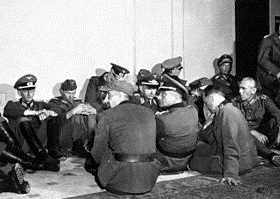 | 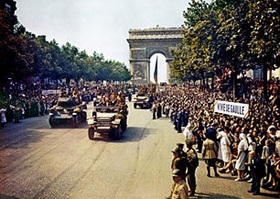 |
Left: High-ranking German officers captured by Free French troops are detained in the Hôtel Majestic, Wehrmacht headquarters during the Nazi occupation of Paris, August 26, 1944. Gen. Dietrich von Choltitz, commander of the German garrison and military governor of Paris, surrendered on August 25 at the Hôtel Meurice, the newly requisitioned headquarters of Gen. Leclerc. Some 12,800 Germans were taken prisoner. (Choltitz, 10 years before his death in 1966, quietly visited his wartime headquarters.)
![]()
Right: The French 2nd Armored Division eventually led the drive toward Paris. A small advance party arrived at the Hôtel de Ville (city hall) late on August 24, 1944. The next day Gen. Leclerc and the rest of his French Armored Division, along with the U.S. 4th Infantry Division, entered the French capital. Gen. de Gaulle arrived in Paris that afternoon. Some sporadic fighting continued for several days following the German capitulation. Nevertheless, on August 26 a great victory parade took place down Paris’ main boulevard, the Champs Élysées, lined with jubilant crowds acclaiming de Gaulle and the French 2nd Armored Division the liberators of Paris. A sign in the crowd reads, “Viva de Gaulle.”
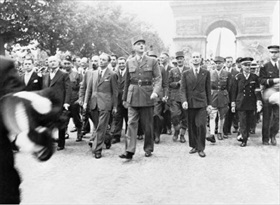 | 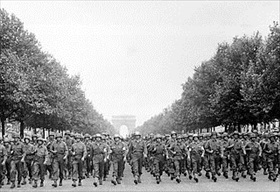 |
Left: Free French head Gen. Charles de Gaulle and his entourage set off from the Arc de Triumphe down the Champs Élysées, destination the iconic Cathedral of Notre Dame for a service of thanksgiving following the city’s liberation on August 25, 1944.
![]()
Right: On August 29, 1944, following the overnight arrival of U.S. Maj. Gen. Norman D. Cota’s 28th Infantry Division, a combined Franco-American military parade was organized. On the saluting dais at the Place de la Concorde were Omar Bradley, commanding general of the Twelfth U.S. Army Group, and Gen. de Gaulle. (British Gen. Bernard Law Montgomery declined the invitation to come to Paris.) This iconic photograph, taken by a member of the U.S. Army Signal Corps, shows the freshly scrubbed infantrymen of the 28th Division, fixed bayonets on their slung rifles, marching in full battle order down Paris’ Champs Élysées directly into combat north of Paris. The men, twenty-four abreast, were accompanied by Jeeps, some mounted with .50 caliber machine guns; 155mm M2 “Long Tom” field guns; and M4 Sherman tanks and tank destroyers.
Contemporary American Newsreel of Liberation of Paris, August 1944
![]()

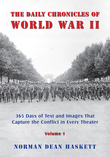 History buffs, there is good news! The Daily Chronicles of World War II is now available as an ebook for $4.99 on Amazon.com. Containing a year’s worth of dated entries from this website, the ebook brings the story of this tumultuous era to life in a compelling, authoritative, and succinct manner. Featuring inventive navigation aids, the ebook enables readers to instantly move forward or backward by month and date to different dated entries. Simple and elegant! Click
History buffs, there is good news! The Daily Chronicles of World War II is now available as an ebook for $4.99 on Amazon.com. Containing a year’s worth of dated entries from this website, the ebook brings the story of this tumultuous era to life in a compelling, authoritative, and succinct manner. Featuring inventive navigation aids, the ebook enables readers to instantly move forward or backward by month and date to different dated entries. Simple and elegant! Click 











